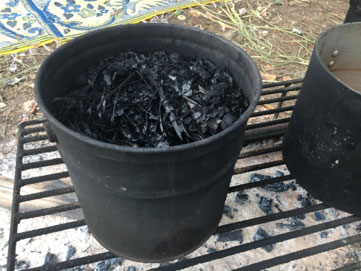| |
My Mapuru Visit June 2018
Recently I visited Mäpuru, which was a marvellous experience. The Arnhem Weavers taught a group of women visitors the skill of basket weaving, part of their rich and ancient culture. The overall trip revealed to me other aspects of Yolngu culture which was clear in the way they live in their present life. Their care for each other and their passionate commitment to the care of their country seemed paramount and were obvious, as was their commitment to maintain the rich and complex Yolngu culture. The entire trip, for me, was truly remarkable and I came away totally respecting this beautiful community. I enjoyed the happy community feel there and the way the children looked after each other and were a pleasure to be with.

After our arrival in the evening, after two days travelling from Darwin, we settled in and the next morning basket weaving began. I sat beside a teacher called Linda who taught us by example and instruction as well. I chose some of the wonderful naturally dyed pandanus fibre and with Linda’s help I proceeded to make a basket. This was thoroughly enjoyable learning a craft passed down through generations for thousands of years. This in itself was an enormous privilege.

I presume the basket weaving was developed over thousands of years for practical reasons, for example to carry tools, food etc. The pandanus was processed and initially woven in its natural undyed form. However, I was told that the coloured natural dyes, sourced from local indigenous plants are a development that occurred in a time more recent than ancient times. From practical beginnings, this craft has become a unique art form.

There were many special times when I personally interacted with these women. One such time a lot of the visitors had either gone fishing, or gone to collect pandanus leaves for processing. I had decided to stay in the weaving shelter to practice my basket weaving. I noticed a Yolngu women sitting apart on a plastic mat pounding something with a roundish stone, perhaps from a riverbed. I approached tentatively and asked if I could watch or join in. This lady, Laura, was very welcoming and led by example. She was taking the bark off the wooden roots of a tree, pounding the bark into a mush, which she used to make a bright yellow dye. Being a natural dyer myself, I was enchanted by this and how the quantities and ratios of matter to be dyed to the amount of dye and liquid, appeared to be a bit ad hoc, and not exact. However, my hunch is that it was exact as it needed to be to achieve a wonderful colour.

This natural approach in itself was fantastic. However, for me, the most special part was relating to Laura, at first tentatively, but later easily, as she explained the words for certain things like grandmother, mother, man, father etc. I suspect she talks quite a bit of English amongst all the other languages she knows. I felt that I really connected with her. As I sincerely thanked Laura for teaching me to prepare the yellow dye materials, she put her arm around me and gave me a sideways hug – this was very special for me.
This was just one experience of the many that I encountered with the happy beautiful Mapuru women.
Meg C.
August 2018
|
|






